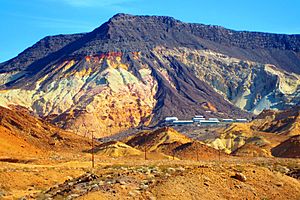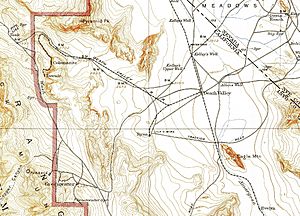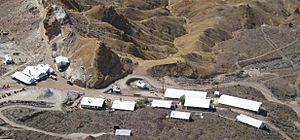Ryan, California facts for kids
Quick facts for kids
Ryan
Ryan Camp
|
|
|---|---|

View of Ryan, California from Death Valley National Park, at the junction of Furnace Creek Road and Ryan Road
|
|
| Country | United States |
| State | California |
| County | Inyo County |
| Elevation | 3,045 ft (928 m) |
Ryan (also known as Ryan Camp) is a small place in Inyo County, California. It is called an "unincorporated community" because it doesn't have its own local government. Ryan used to be a mining community and a "company town." This means a company owned most of the homes and businesses.
Today, Ryan is privately owned. The Death Valley Conservancy takes care of it. Ryan is located high up in the Amargosa Range. It sits about 3,045 feet (928 meters) above sea level. It is about 8 miles (13 km) northeast of Dante's View. It is also about 15 miles (24 km) southeast of Furnace Creek.
Contents
How Ryan Got Its Name

The first mining town here was built in 1907. It was called Lila C. This town was near the Lila C mine. The mine produced a mineral called colemanite. This mineral was used to make borax. The owner, William Tell Coleman, named the town after his daughter, Lila C. Coleman.
Soon after, the town of Lila C became known as "Ryan." This was to honor John Ryan (1849–1918). He was the General Manager of the Pacific Coast Borax Company. He was a trusted worker for "Borax" Smith until he passed away in 1918. The Ryan post office opened at Lila C in 1907.
In 1914, a new mining camp was built about 11 miles (18 km) away. This new place was first named Devar. This name was a short way of saying "DEath VAlley Railroad." (It was sometimes misspelled as Devair on old maps). Later, its name was also changed to Ryan. This was again to honor John Ryan. The new camp is the one known as Ryan, CA, or Ryan Camp today.
Ryan's Story: From Mining to Tourism
Ryan was the end point for the Death Valley Railroad. This railway carried borax ore from the mines. The other end of the railroad was at Death Valley Junction. This was where the borax was processed.
The Death Valley Conservancy says that Ryan was a very nice mining camp. It had electricity, steam heat, and even refrigerators. It also had a school, a hospital, and a post office. There was a recreation hall that also served as a church. It even had a general store for supplies.
Mining for borax stopped in 1928. The Pacific Coast Borax Company wanted to make money from its railroad. So, they turned the miners' homes into places for tourists to stay. Visitors to Death Valley could take trips on the narrow gauge railway into the mine. The Death Valley View Hotel was open from 1927 to 1930. In 1930, the Death Valley Railroad stopped running. After that, the hotel was used for extra guests from other nearby hotels until the 1950s.
Today, the Death Valley Conservancy takes care of Ryan Camp. The company Rio Tinto Borax Corporation gave Ryan Camp to the Conservancy in 2013. The Death Valley Conservancy is a nonprofit group. It works to protect and preserve the area.
Visiting Ryan Today
Ryan is not open to the public all the time. This is for safety and to protect its history. However, the Death Valley Conservancy sometimes offers public tours. If you want to join a tour, you can sign up on the Death Valley Conservancy's Ryan Tours webpage.
Ryan's Desert Climate
Ryan has a lot of sunshine all year. This is because of the stable air and high pressure in the area. Ryan has a desert climate. This type of climate is called "Bwh" on climate maps. This means it is very hot and dry.



